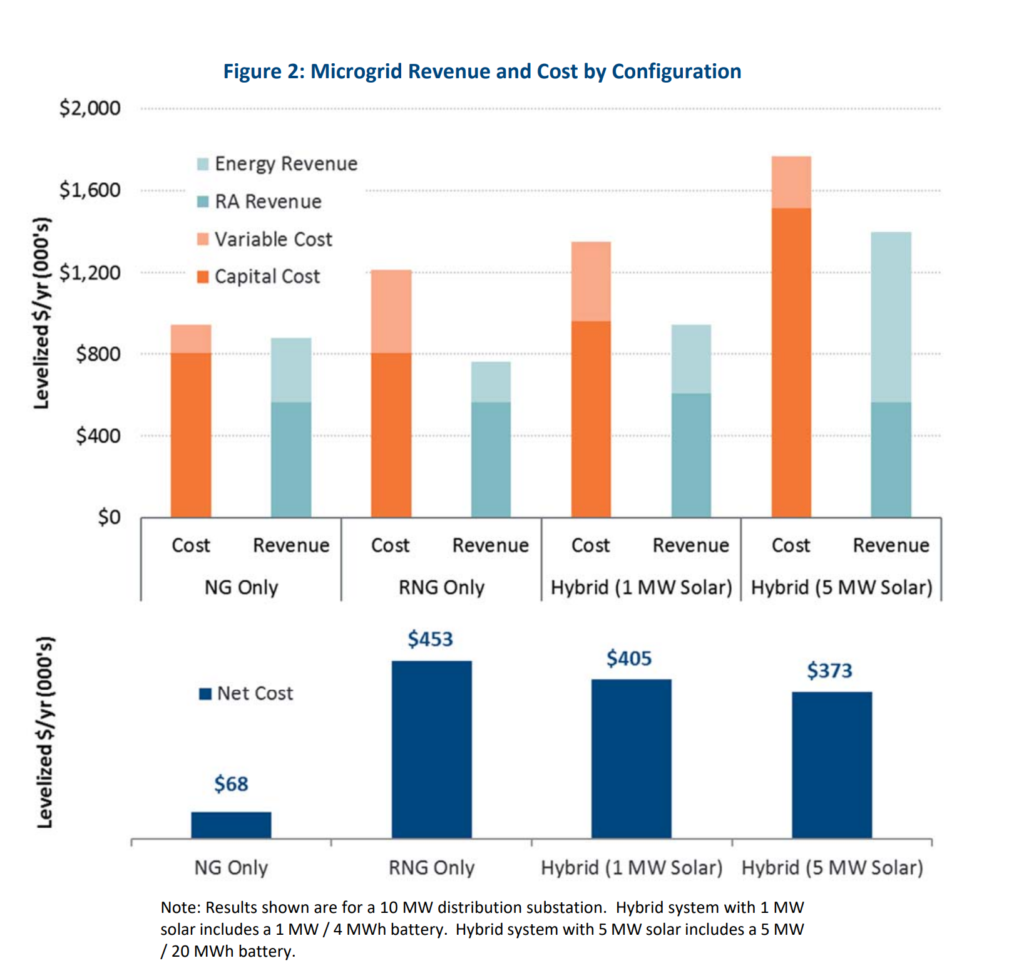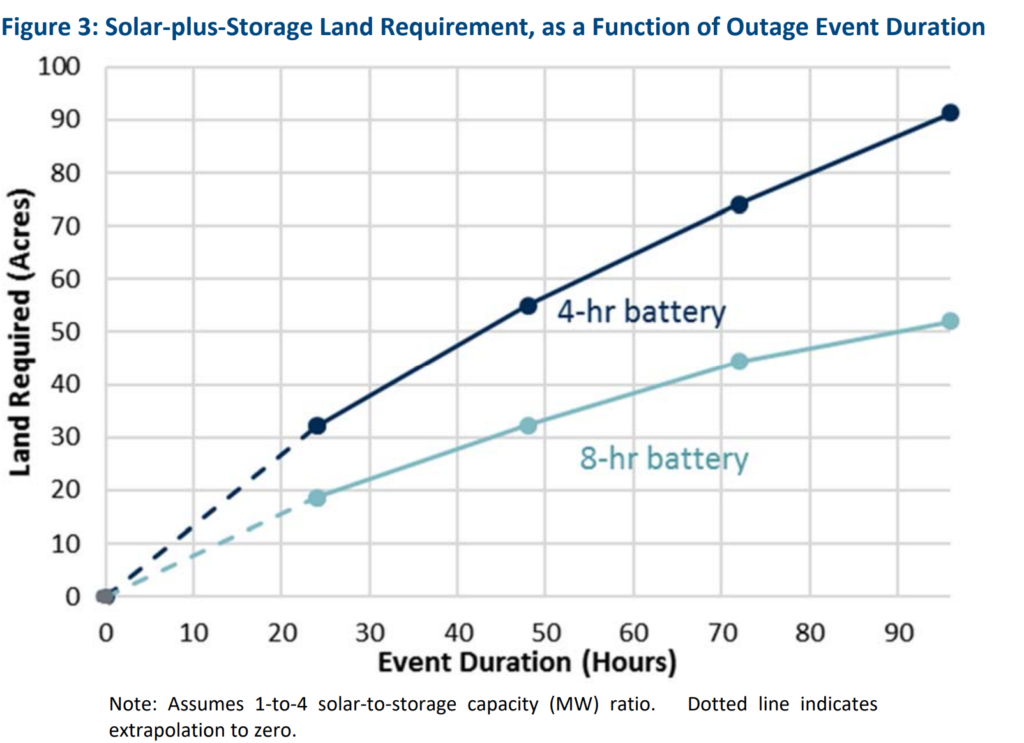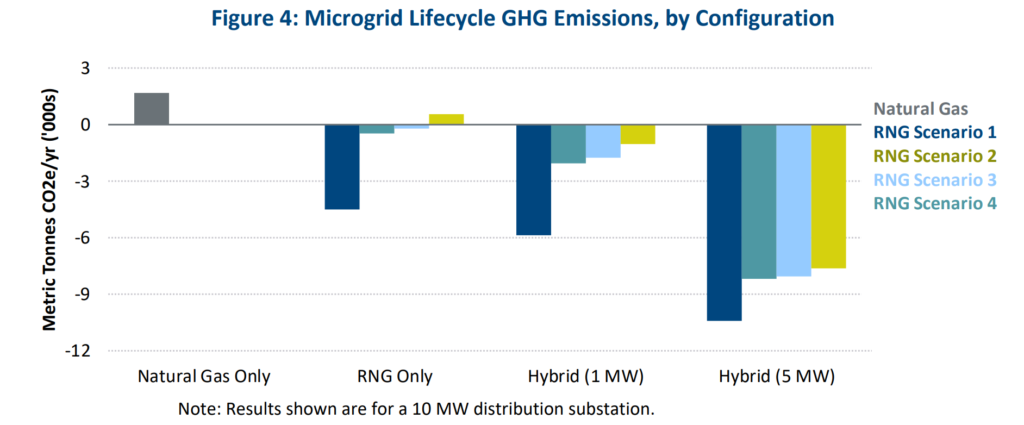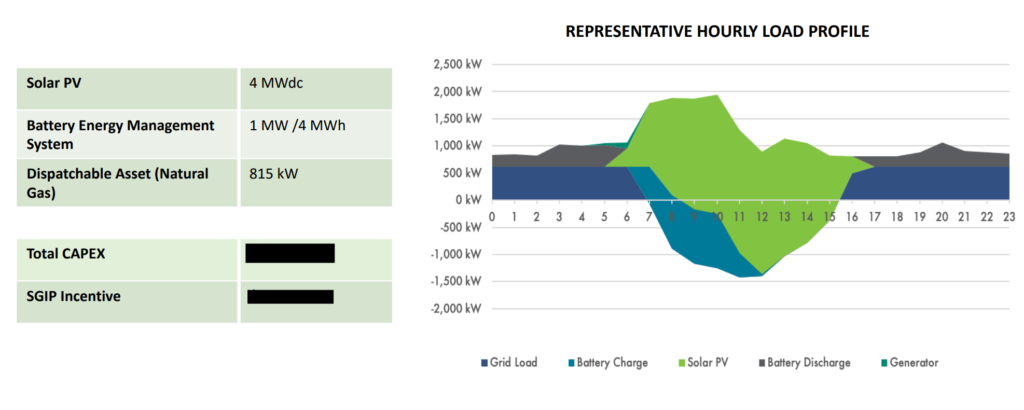The Brattle Group has released a report, Decarbonized Resilience: Assessing Alternatives to Diesel Backup Power, focused on microgrid solutions that could provide 100% reliability to all loads served by a 10 MW distribution substation in Northern California for two to four consecutive days. This specific focus was chosen because of the Public Safety Power Shutoffs going on in wildfire regions of California.
The report looks at four different types of microgrids – natural gas (NG), renewable natural gas (RNG), community scale solar+storage, and a community scale hybrid system of solar+storage+RNG). The projects are modeled financially selling into the wholesale electricity and resource adequacy markets in a projected 2028 California market that has a lot more renewables, and energy storage.
Energy storage was priced at $265/kWh, and included a 22% Investment Tax Credit. Solar power was priced at $1.10/watt DC using single axis trackers, with land prices of $44,000/acre.
The first result of the study is that only three of the four microgrid types are viable for 4 day, 100% reliability power grids – those containing some sort of gas. The solar+storage alone was not considered technically feasible within the region due to land constraints noted below.
The NG microgrid benefits include a minimal physical footprint, quick installation times, near-instantaneous response times, and virtually no operational constraints (e.g., no minimum run times and extremely fast ramp rates). Over its lifetime, the plant will cover its costs even while running only 3% of the time. This low run rate, about 11 days worth over the course of the year, means that the total amount of emissions from these systems is very minimal relative to emissions goals of 100% clean electricity.
The RNG system offers many of the same benefits as the NG system, except lower emissions due to the source of the fuel being mostly methane captured from dairy farms and landfills. As the methane is burnt, it still releases CO2 – but since the methane would have been flared or released otherwise, the net effect is of lower emissions. The revenue from this system is lower though, as the cost of RNG is high than NG.
Solar+Storage and +Gas Microgrids
The solar+storage system alone has issues that led to the author’s stating it isn’t a viable solution. To generate enough electricity to meet federal guidelines providing 100% uptime over four days at a 10 MW substation, means 20+ MW of solar, and an energy storage system of 90 MW/350 MWh. Per the researchers, the 90 acres needed is an order of magnitude greater than the largest available nearby substations defined as ‘at risk’. A single day of 100% reliability would require ~25 acres.
In addition to land challenges, the size of the system (20 MW+) means it’d need to be connected to the transmission side of the substation, which would require high-capacity hardware that increases system costs.
As this system was deemed not viable, no financial modeling was done.
The hybrid solar+storage+RNG system was technically viable though. The group modeled two of these systems – a 4 acre, 1 MW of solar + 1 MW/4 MWh battery system coupled with a 9.7 MW RNG generator. And a second system on 20 acres of land with 5 MW of solar, a 5 MW/20 MWh battery and a 5 MW gas generator.
Financially speaking the hybrid systems make better economic sense than the RNG system on its own, but the numbers aren’t as strong as the NG system on its own. The out of pocket costs were much higher, but so were the revenues. The larger hybrid system might have the higher ROI of the two, but it also costs a healthy amount more.
From an emissions standpoint, very clearly, the large hybrid solution plus RNG leads to the least amount of emissions. RNG does have challenges though – it need to scale, it needs efficient paths to get into existing gas pipeline infrastructure, and for the emissions to match the reductions in the above chart it needs come from a pre-existing source that would have been flared or released into the atmosphere.
The authors do note though, when it comes to total emissions – these solutions are all cleaner and cheaper than diesel generators.
Scale Microgrid Solutions
Currently, CommercialSolarGuy is working with Scale Microgrid Solutions to develop a system much like what is covered in this report. The project is to protect a single entity though – a California water district’s water filtration system. And, coincidentally, it just so happens to have land constraints that have limited our system size to about 4 MWdc.
The system is designed with solar+storage+NG. The water filtration site also flares its methane, which we plan to integrate into the overall project– meaning we will really have a solar+storage+NG+RNG.
The biggest issue with the gas generator is simply that it burns something. However, looking at the above chart – you can just barely make out the sliver of gas generator usage projected at the beginning of the solar day. The gas will run at a 5% capacity factor – meaning a capacity factor higher than those modeled above, but still leading to an overall reduction in emissions at the site of 95%.
On site currently, the District has multiple large diesel generators as backup. However, during a recent fire – which literally came up to fence of the facility (below image from a site visit of mine) – the local police force didn’t allow District employees to access sites to turn on the generators as it was considered a high safety risk.
Diesel is no longer a viable solution, and CommercialSolarGuy hopes to see this project deployed by the third quarter of 2021. The Water District will save six figures a year for a few decades with the project.
https://www.instagram.com/p/B4n3UKonK0q/




